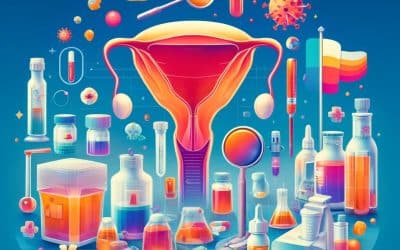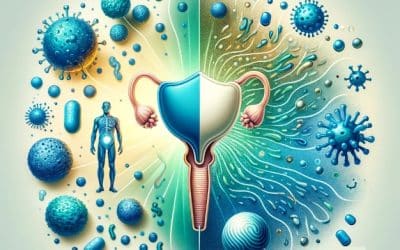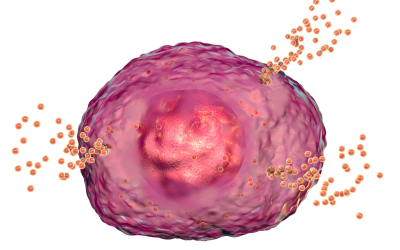It is no secret that exercise is very important for optimal health. But many people still do not see the connection and it seems to be a low priority for them when it comes to managing their health. However, I realize that many people truly do not understand how important it really is, even from the perspective of glycolytic pathway, so I want to take the time to summarize it here. Exercise is known to stimulate glycogenolysis, especially when it is conducted first thing in the morning after an overnight fast. In fact, I often tell my clients to do their exercise fasted when they want to optimize weight loss. But how does it work?
Before I review that, I want to do a quick summary of biochemistry.
In our muscles, glycogen supplies glucose-6-phosphate for ATP synthesis in the glycolytic pathway. Any enzyme known as glycogen phosphorylase in the muscle is stimulated during exercise by the increase of AMP and by phosphorylation. The phosphorylation is stimulated by calcium released during contraction and by epinephrine, the fight or flight hormone, as well as hypoglycemia during stressful situations or exercise where there is an immediate need for glucose. It is important to understand that liver glycogen stores are principally for the support of blood glucose during fasting or extreme need such as exercise, and the degradative and biosynthetic pathways are regulated principally by changes in the insulin/glucagon ratio and by blood glucose levels. The key point to remember is that muscle glycogenolysis is regulated principally by AMP, which signals a lack of ATP, and by Ca2+ released during contraction. Epinephrine, which is released in response to exercise and other stress situations, also activates skeletal muscle glycogenolysis.
Let’s take a practical look at what happens when someone begins to contract their muscles during exercise. If someone were to immediately begin running as fast as possible, the following cascade would take place.
- Within 3 seconds, muscle cells exhaust stored ATP.
- As exercise continues, this ATP must be regenerated, so the ATP–PCr system kicks in to shoulder most of the load. This lasts for about 10 seconds. And because time is required for ATP to be regenerated, you start to slow down a bit.
- As exercise continues and the ATP–PCr stores are depleted, the glycolytic system will begin to provide most of the energy transfer for ATP regeneration. This lasts for about 90 to 120 seconds or so, depending on the intensity of the exercise. Since the glycolytic system generates ATP more slowly than the ATP–PCr system, again, you have to slow down a bit more.
- If exercise continues beyond this time frame, the oxidative system will start to provide most of the energy transfer for ATP regeneration. And again, because the oxidative systems are slower than the anaerobic systems, the pace must slow again. In fact, if the pace is slow enough, the exercise can last for quite a long time.
There are two main types of exercise: anaerobic exercise and aerobic exercise. Anaerobic exercise is defined as higher-intensity, shorter-duration (less than 2 minutes) activity, whereas aerobic exercise occurs when the exercise is longer than 2 minutes in which the oxidative system must kick in to provide the remaining energy for ATP regeneration. As our initial energy stores can only supply energy for about three seconds, our ATP must be regenerated in large amounts, and quickly, to support this type of exercise.
Short-burst activities such as the following:
- The golf swing
- Field events (shot put, discuss)
- Gymnastics
- The tennis swing
- The 100-meter sprint
- The baseball swing
- Diving
Oxidative energy transfer takes place in the mitochondria of our cells and utilizes a combination of muscle glycogen, intramuscular fatty acids, free fatty acids, and amino acids. As the oxidative processes utilize breakdown products from both glycolysis (glucose through to pyruvate) and beta oxidation (fatty acids through to acetyl-coA), energy transfer occurs at a slower rate. However, what this system lacks in speed, it makes up for in ATP regeneration. As a result, oxidative metabolism can support activities including the following:
- 800-meter run
- 2000-meter rowing
- 1500-meter skating
- Cross-country skiing
- Jogging
- Walking
- Long-distance swimming
Indeed, any activity done at a high intensity for longer than two minutes derives a large percentage of its energy transfer from the oxidative system. There is a “switchover point” at which an activity moves from anaerobic to aerobic, as seen in this interesting comparison.
- 200-meter run: 29% aerobic; 71% anaerobic
- 400-meter run: 43% aerobic; 57% anaerobic
- 800-meter run: 66% aerobic: 34% anaerobic
- 1500-meter run: 84% aerobic; 16% anaerobic
The primary muscle fiber types that contribute to aerobic exercise are the oxidative type I and type IIA fibers. As aerobic exercise is heavily oxygen dependent, training adaptations occur in order to support oxygen transport and delivery in these fibers. Specifically, aerobic exercise can increase the number and size of the blood vessels. This occurs through increased capillarization. Specifically, with aerobic training, there is a greater number of capillaries per unit of muscle. This allows for enhanced delivery of oxygen (fuel) to muscle cells, enhanced removal of CO2 and waste products, and the transfer of heat away from the muscle. In addition to enhanced oxygen delivery, there is an increase in the size and number of mitochondria along with greater myoglobin content within cells. While the greater capillarization leads to more oxygen transport, the greater myoglobin leads to increased muscle oxygen uptake, and the larger and more numerous mitochondria allow for greater oxygen use. Of course, in addition to these adaptations, the enzymes involved with aerobic energy transfer will adapt as well.
Let’s talk a bit about oxygen and the adaptations that occur with regular exercise.
After a full exercise session, or even after a single interval within an entire exercise session, the oxygen deficit that’s accumulated must be paid back. This means that after you’ve stopped exercising and the amount of mechanical work you’re doing is no different than you’d be doing at rest, you still continue to consume more oxygen. This period of increased oxygen consumption and energy demand has been called the period of oxygen debt or EPOC (excess post-exercise oxygen consumption). In essence, after exercise, the amount of oxygen consumed can be elevated for minutes to hours. This is due to the fact that the body must:
- a) metabolize additional nutrients,
- b) replenish the energy stores that have been used up, and
- c) reload the depleted oxygen stores in the muscle and blood.
In addition to these recovery-type activities, the following also contribute to the EPOC:
- Elevated post-exercise body temperature
- Increased activity of the heart and respiratory muscles
- Elevated levels of metabolism-boosting hormones
- Increased conversion of energy transfer products such as lactate into other substrates
- Increased protein synthesis
- Recovery of muscles stressed and damaged with the activity
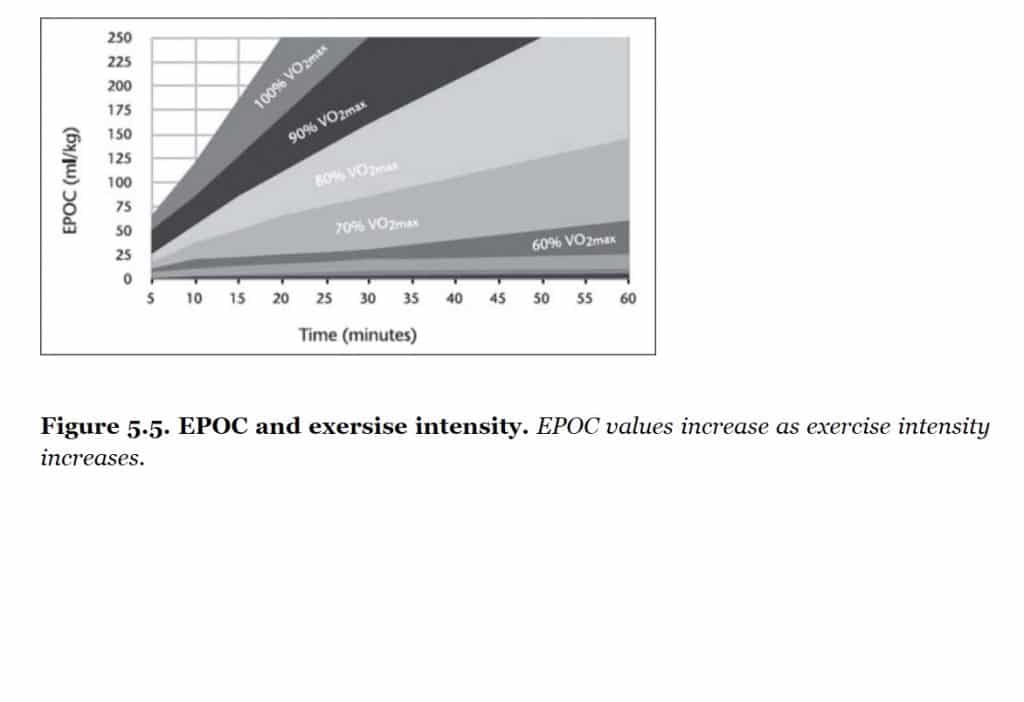
It is important to note, however, that the energy systems do not work independently from one another. During various types of exercise, from aerobic to anaerobic, all three energy systems are activated. However, the extent to which they are activated, and the amount of ATP they regenerate relative to the total ATP regeneration required, determines the description of the activity. For example, during short-burst activity, the ATP–PCr system is most important. When immediate and explosive movement is desired, the brain initiates the contraction with a signal that’s passed along the nerves to the muscles. The muscles then contract, using ATP and depleting these immediate energy stores within a second or two. In order for the muscles to continue to contract, the resulting ADP and P must be regenerated to ATP.
Adaptations to Exercise.
In response to regular exercise training, whether anaerobic or aerobic, certain changes occur in the muscle. These changes improve the body’s ability to respond to similar exercise challenges in the future. Each of these processes is regulated by protein synthetic mechanisms initiated within our genetic material (our DNA). Cellular communication through hormones is intimately involved in this process. The hormone insulin, in the presence of adequate nutrient availability, encourages the stimulation of protein synthesis and a positive nitrogen balance. Insulin availability is greatest during well-fed conditions and during periods of energy surplus. Protein and amino acid intake is key here as protein-containing meals stimulate a positive protein status. In addition, hormones like testosterone and growth hormone have a stimulatory effect on muscle adaptation.
On the other hand, the counter-regulatory hormones such as glucagon, catecholamines, and glucocorticoids have a contradictory effect, promoting protein breakdown and a negative nitrogen balance. These hormones are released in large numbers during periods of fasting or energy deficit
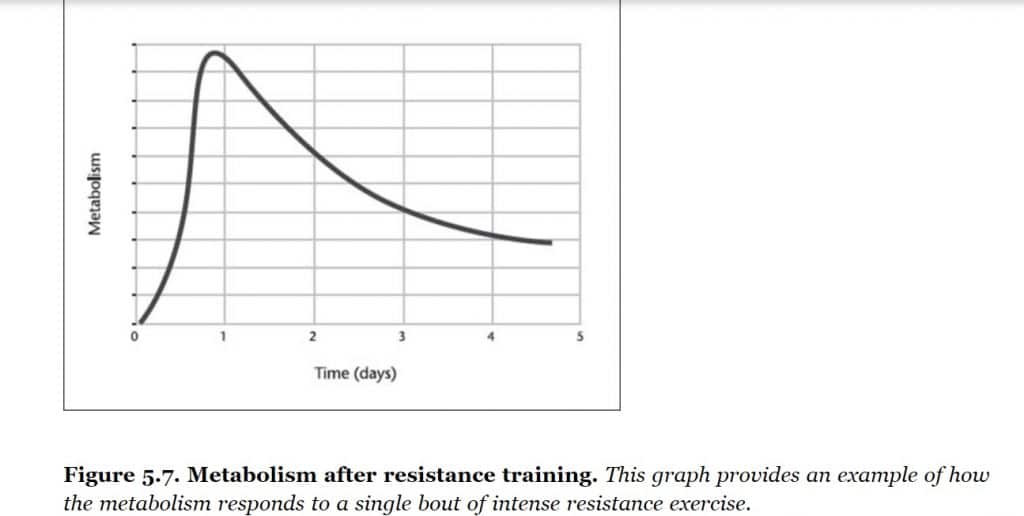
Protein synthesis and exercise adaptation are also affected by:
- The amount of mRNA in our cells
- Ribosomal number
- Ribosomal activity
- Amino acid availability
- The hormonal environment
- Our native genetic code
Interestingly, even the process of recovering and adapting to our exercise training demands is metabolically costly. As proteins are degraded and amino acids re-synthesized into proteins, this process of protein turnover builds more functionally adapted enzymes, contractile units, etc. And this process accounts for between 10% and 25% of resting energy expenditure. Therefore, as you can see, not only does exercise increase total daily energy expenditure during the activity, it also increases post-exercise expenditure through two mechanisms. Energy expenditure is increased due to both the oxygen debt being paid back and to the increased protein turnover and synthesis just described.
Adaptations of anerobic exercise such as weight training and sprint training:
- muscle fibers both increase in size and in myofibrillar number
- mitochondrial size and number
- increases in myoglobin number
- increases in intracellular storage capacity and availability (such as stored glycogen)
- increases in intracellular glycogen storage can also contribute to muscle hypertrophy
- In addition to changes in muscle cross-sectional area, anaerobic exercise can enhance the activity of ATP–PCr system enzymes (creatine kinase, myokinase) and the glycolytic system enzymes (glycogen phosphorylase, phosphofructokinase).
These changes help to increase the rate of energy transfer within the muscle, allowing for more rapid responses to energy demands in the future.
Adaptations to aerobic exercise such as jogging, steady state cardio or swimming:
Please note, this type of lower-intensity, longer-duration activity primarily influences muscle quality (as opposed to muscle size).
- Enhancement of oxidative or mitochondrial enzyme activity
- Increase in intramuscular glycogen and triglyceride content
- Increase in blood volume due to increase uptake and delivery of aerobic activity- due to increase in red blood cell content and the oxygen-carry capacity of the body.
- Capillary density of trained muscles increases- meaning there will be a great number of capillaries per muscle fiber
- With this lengthened border between blood vessels and muscle fibers, oxygen delivery, carbon dioxide removal, waste removal, fuel delivery to muscle, and the transfer of heat are all amplified.
- Beyond this, the myoglobin content of skeletal muscles will increase, improving oxygen delivery across muscle cells
- Finally, the number and size of mitochondria are increased with aerobic activity of high enough intensity. This promotes greater oxygen utilization through the process of pyruvate, fatty acid, and ketone utilization through the Krebs cycle and electron transport chain
Additional benefits of both aerobic and anaerobic exercise training include:
- The attenuation of sympathetic nervous system activity.In essence, “stress” to the body with exercise is minimized over time, and therefore greater workloads are required to promote the same amount of adaptation.
- Greater insulin sensitivity.With exercise training, the body responds to carbohydrate intake with less insulin release, allowing insulin to act in carbohydrate update and protein synthesis without preventing fat loss/stimulating fat gain.
- Improved fatty acid uptake and transport.Another positive response to exercise training is that fats can be more easily mobilized from adipose tissue, transported, taken up, and broken down.
- Less lactate produced per intensity.At every intensity, less lactate will be produced. This is due to greater aerobic production of ATP at every intensity, lower catecholamine response, reduced carbohydrate metabolism, and changes in the isoenzymes of lactate dehydrogenase to forms that favor the conversion of lactate to pyruvate.
- More lactate removed per unit of intensity.At every intensity, more lactate will be removed. Increased rates of lactate removal are due to increased blood flow to the liver and enhanced uptake of lactate by cardiac and skeletal muscles.
- Better lactate tolerance.With training at the highest intensities, the body can better deal with high acid conditions and high levels of lactate. This means higher intensities can be achieved and sustained for short periods of time.
sympathetic nervous system: One division of the autonomic nervous system that is always active and provides sympathetic tone. Its activity increases during times of bodily stress.
So, what qualifies as “intense exercise”? Resistance training (strength training), interval training(through activities such as running, climbing, cycling, and rowing), circuit training, rope jumping, running hills, squat thrusts, plyometrics, explosive medicine ball work, explosive kettlebell exercises, and strongman activities are all high-intensity activities.
Basically, high-intensity activity includes any physically demanding task that:
- a) incorporates many muscle groups, and
- b) is done near your maximum heart rate.
The high-intensity activities listed above require a maximum of muscle activity, which leads to high amounts of cellular stress and the need for muscle adaptation. It’s this muscle stress and adaptation that brings about the maximum number of benefits, including increased protein turnover, muscle preservation and building, a high energy cost, and even cardiovascular benefits.
However, as important as exercise is to this process, nutrition is equally critical.
Firstly, nutritional status can impact energy transfer. Therefore, a good nutrition program will help facilitate top performance of each of the energy systems: ATP–PCr, glycolysis, and oxidative phosphorylation. Both macronutrients and micronutrients are important here.
A sub-optimal nutritional intake can reduce enzyme efficiency (due to deficiencies of co-enzymes and co-factors) and lead to substrate deficiencies. And this means poor exercise performance and fewer calories burned both at rest and during exercise. So much for the metabolic and muscle preserving and building benefits of exercise. In addition, with an inadequate intake of dietary protein and fat, amino acid availability and the ratio of anabolic to catabolic hormones can be compromised. This can lead to an inability to build and preserve muscle mass, even in the face of a solid exercise program.
For more information on how IC Healer can help you , Book a Discovery Call today.
Sign up for my FREE GUIDE



